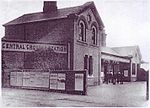Big Apple Records
Defunct record labelsDefunct record labels of the United KingdomDubstep record labelsRecord labels

Big Apple Records was a record shop and label in Croydon, South London that opened in 1992 and closed in 2004, although the label continued to release music until 2007. It is known for pioneering the sound of dubstep in the early 2000s, with dubstep DJs and producers working in and frequently visiting the shop. The record label was the first to sign Skream and Benga.
Excerpt from the Wikipedia article Big Apple Records (License: CC BY-SA 3.0, Authors, Images).Big Apple Records
Surrey Street, London Broad Green (London Borough of Croydon)
Geographical coordinates (GPS) Address Nearby Places Show on map
Geographical coordinates (GPS)
| Latitude | Longitude |
|---|---|
| N 51.373055555556 ° | E -0.10138888888889 ° |
Address
Erol's Cafe
Surrey Street 23
CR0 1RG London, Broad Green (London Borough of Croydon)
England, United Kingdom
Open on Google Maps










